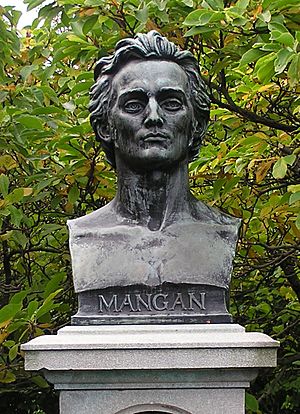James Clarence Mangan facts for kids
James Clarence Mangan, born James Mangan (Irish: Séamus Ó Mangáin; 1 May 1803, Dublin – 20 June 1849), was an Irish poet. He freely translated works from German, Turkish, Persian, Arabic, and Irish, with his translations of Goethe gaining special interest. Starting around 1840, and with increasing frequency after the Great Famine began, he wrote patriotic poems, such as A Vision of Connaught in the Thirteenth Century. ..... He died early from cholera, amid the continuing dire conditions of the Famine. After his death, Mangan was hailed as Ireland's first national poet and admired by writers such as James Joyce and William Butler Yeats.
Early life
Mangan was born at Fishamble Street, Dublin, the son of James Mangan, a former hedge school teacher and native of Shanagolden, County Limerick, and Catherine Smith from Kiltale, County Meath. After marrying Smith, James Mangan took over a grocery business in Dublin owned by the Smith family, eventually becoming bankrupt as a result.
Mangan described his father as having "a princely soul but no prudence", and attributed his family's bankruptcy to his father's suspect business speculations and tendency to throw expensive parties. Thanks to poor record keeping, inconsistent biographies, and his own semi-fictional and sensationalized autobiographical accounts, Mangan's early years are the subject of much speculation. However, despite the popular image of Mangan as a long-suffering, poor poet, there is reason to believe that his early years were spent in relative middle class comfort.
He was educated at a Jesuit school where he learned Latin, Spanish, French, and Italian. He attended three schools before the age of fifteen. Obliged to find a job in order to support his family, for seven years he was a scrivener's clerk and for three years earned meagre wages in an attorney's office, and was later an employee of the Ordnance Survey and an assistant in the library of Trinity College, Dublin.
Literary career
Mangan's first verses were published in 1818. From 1820 he adopted the middle name Clarence. In 1830 he began producing translations – generally free interpretations rather than strict transliterations – from German, a language he had taught himself. Of interest are his translations of Goethe. From 1834 his contributions began appearing in the Dublin University Magazine. In 1840 he began producing translations from Turkish poetry, Persian poetry, Arabic poetry, and Irish poetry. He was also known for literary hoaxes; some of his "translations" are in fact works of his own, like Twenty Golden Years Ago, attributed to a certain Selber. His connection with The Dublin University Magazine was terminated because his habits rendered him incapable of regular application.
He was friends with the patriotic journalists Thomas Davis, and John Mitchel, who would write his biography. His poems were published in their newspaper The Nation. Mangan was for a time paid a fixed salary, but, as on former occasions, these relations were broken off, though he continued to send verses to "The Nation" even after he had cast in his lot with Mitchel, who in 1848 began to issue The United Irishman.
Although his early poetry was often apolitical, after the Famine he began writing patriotic poems, including influential works such as Dark Rosaleen, a translation of Róisín Dubh and A Vision of Connaught in the Thirteenth Century.
His best known poems include Dark Rosaleen, Siberia, Nameless One, A Vision of Connaught in the Thirteenth Century, The Funerals, To the Ruins of Donegal Castle, Pleasant Prospects for the Land-eaters and Woman of Three Cows. He wrote a brief autobiography, on the advice of his friend Charles Patrick Meehan, which ends mid-sentence. This must have been written in the last months of his life, since he mentions his narrative poem of the Italian Gasparo Bandollo, which was published in the Dublin University Magazine in May 1849.
..... There are many descriptions of his personal appearance at this time, all of them dwelling on his spare figure, his tight blue cloak, his witch's hat, his inevitable umbrella. He was described by the artist William Frederick Wakeman as frequently wearing "a huge pair of green spectacles", padded shirts to hide his malnourished figure, and a hat which "resembled those which broomstick-riding witches are usually represented with". ..... He was buried in Glasnevin Cemetery.
Style
Mangan's poetry fits into a variety of literary traditions. Most obviously, and frequently, his work is read alongside such nationalist political authors as John Mitchel, as they appeared in The Nation, The Vindicator and the United Irishman newspapers; or as a manifestation of the 19th-century Irish Cultural Revival. It is hard not to acknowledge Mangan's debts to such translators and collectors of traditional Irish poetry as Samuel Ferguson and James Hardiman; many of Mangan's poems, for instance Dark Roseleen, appear to be adaptations of earlier translations rather than original translations.
Mangan is also frequently read as a Romantic poet. In particular, he is compared to Samuel Taylor Coleridge and Thomas De Quincey, largely thanks to his rumoured opium addiction and tendency to place his writing within the frame of a vision or dream.
More recently, critics have begun to read Mangan's work as a precursor to modernist and postmodernist experimental writing. His playful literary hoaxes and fake translations (which he called "reverse plagiarism") have been seen as a precursor to the works of Flann O'Brien.



